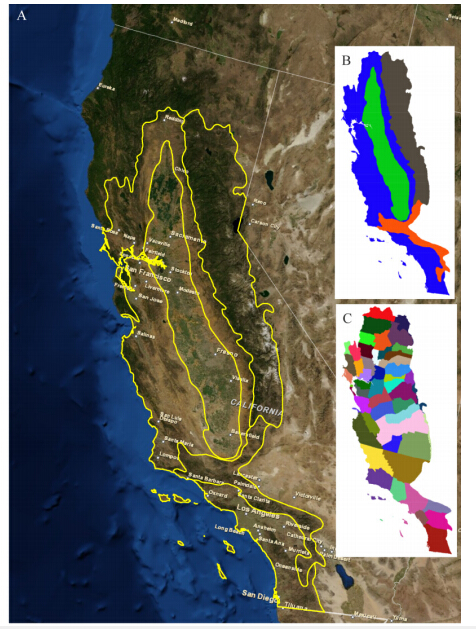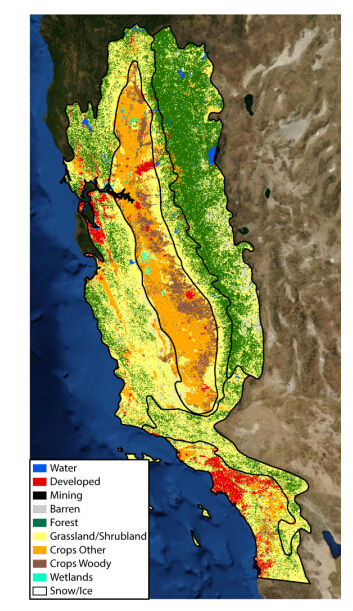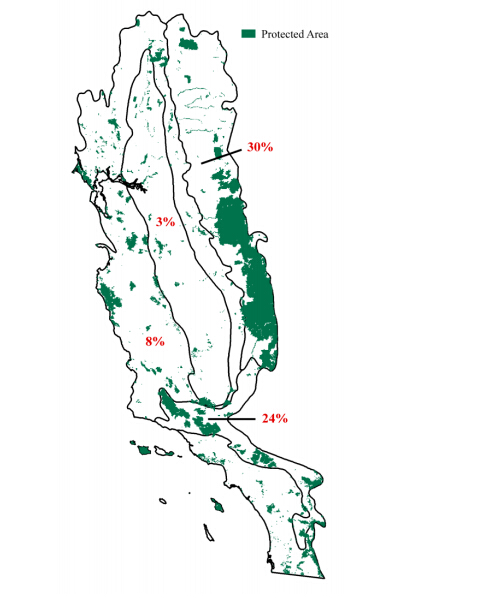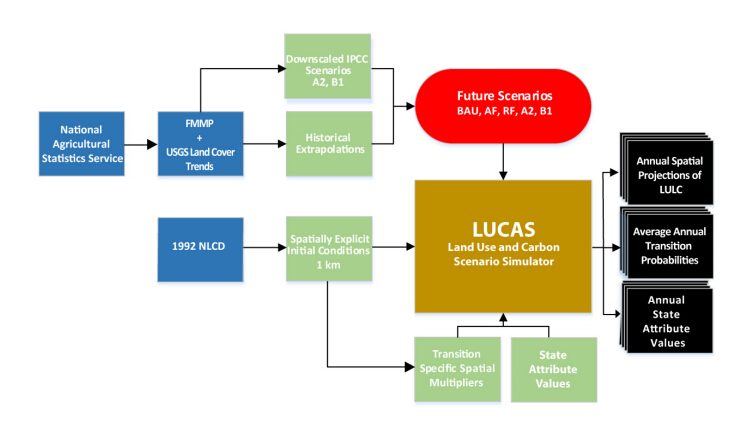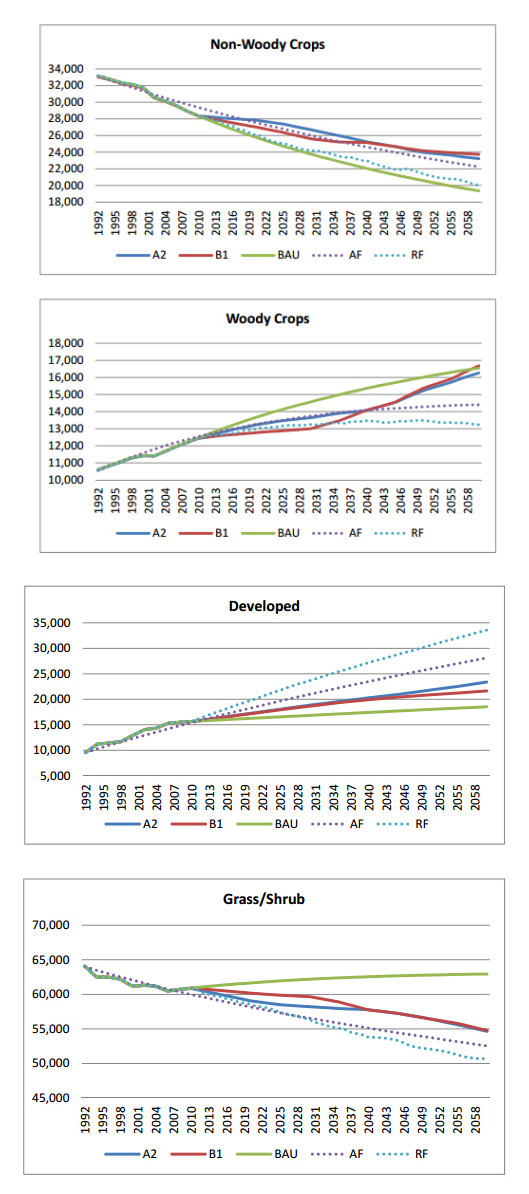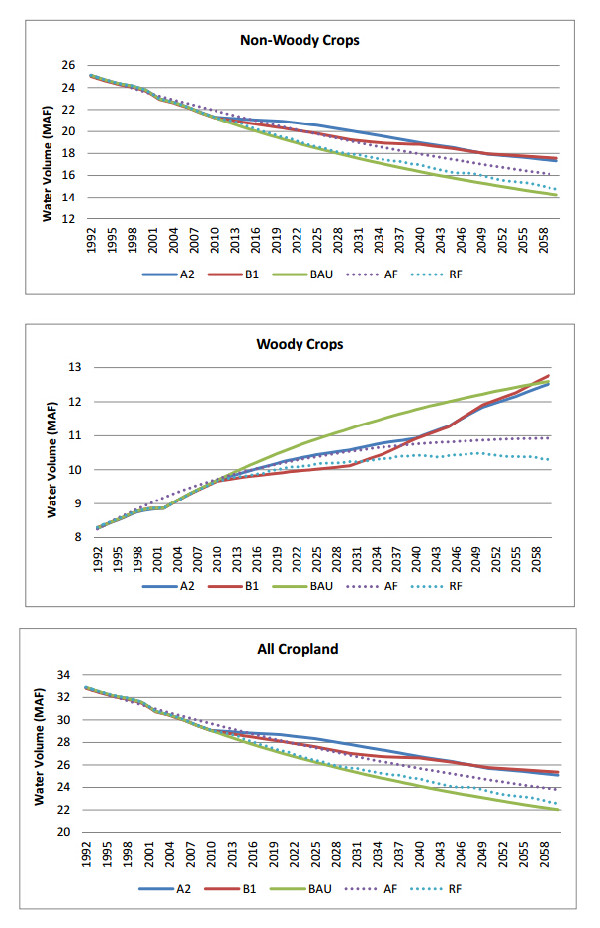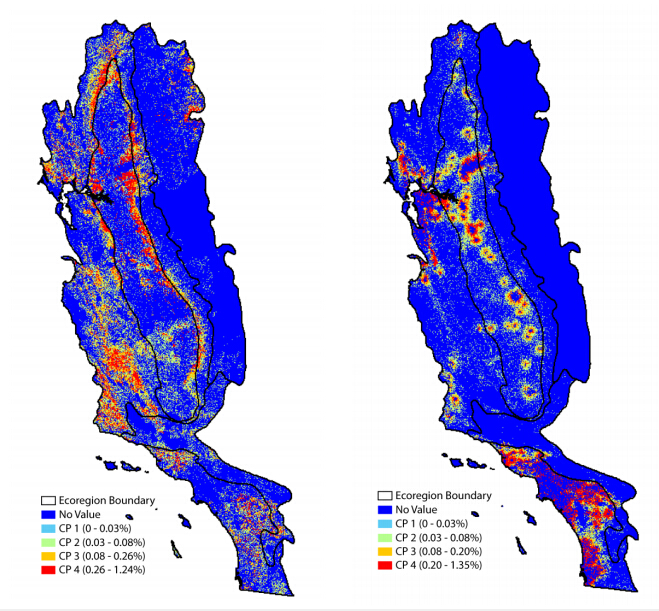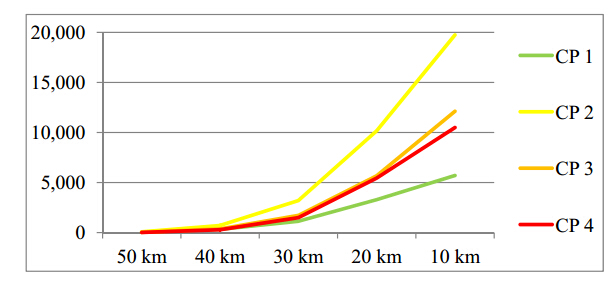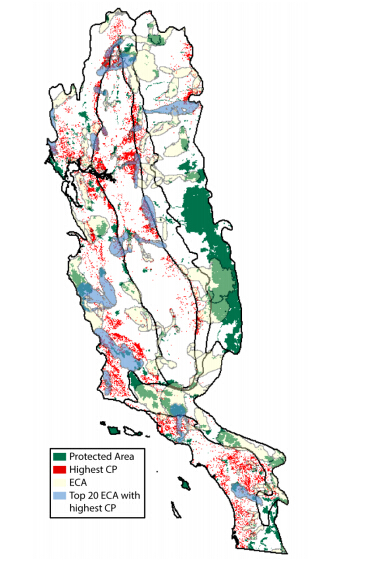1. Introduction
It is estimated that human land use has already impacted more than 1/2 of the Earth’s landsurface in the last 300 years alone [1], with roughly one-third of the conterminous United States in 1992 classified as human-dominated [2]. For California, with one of the largest economies in the world and an already highly diverse and intensive land-use mosaic, future land-use change will only intensify in the coming decades [3]. California is currently home to an estimated 38 million people [4]―with a doubling or more of population expected this century [5]. The associated dem and for California’s limited, intensively-allocated water resources will undoubtedly grow [6] while climate projections predict multi-year drought in the western U.S. and shrinking future water supply [7]. Global population will continue to rise as well, leading to increased international dem and for food, fiber, energy, and development which will influence land use and land change in the state. Human land use can lead to widespread ecosystem alteration via habitat loss [8], species extinction [9], loss of diversity [10], declining air and water quality [11,12], increasing CO2 emissions [13], and indirect forcing of climate change [14,15]. Even if species are able to adapt to a changing climate and migrate to suitable habitat, human land use will be a significant dispersal barrier. By the year 2060, impacts from anthropogenic land use on biodiversity will likely be greater than those related to climate change [16,17]. Land use also affects resource availability. Agriculture in California is the largest consumer of the state’s limited water resources. Drought recurrence in the past few decades has led to improved water use efficiency for some crops [18]. The last two decades have also seen a widespread shift from row crops to higher valued vineyards and orchards, with land in orchards increasing roughly 9% while total cropland area has remained relatively constant [19,20,21,22,23]. Shifting to more perennial crop types has generated a shift in agricultural water use dem and. Between 1972 and 2002, land irrigated by low-volume (drip and micro sprinkler) irrigation has increased by about 33%, with an associated 31% decrease of land irrigated by surface methods [18]. If these trends persist, agricultural water use would be expected to change. If agriculture expand s or declines, overall cropland water use will also be impacted. Underst and ing the range of potential future agriculture land and water-use scenarios can help resource managers develop stronger mitigation plans in the face of increasing shortages and shifting dem and to urban water use as population and urban areas expand [24].
The research community has highly developed, refined, and vetted species distribution models and global circulation models. Models of future land use, however, are sparse despite keen interest in the biodiversity community for projections of future land use and land conversion [2,25]. Mapping and monitoring the rates of spread of threats to biodiversity has been identified as a way to better underst and the present and future distribution of threats and can help focus limited resources on areas at most risk [25,26]. We developed a state- and -transition simulation modeling (STSM) framework to project spatially explicit (1 km2) land use and land cover (LULC) from 1992-2060 for five different future scenarios, in order to identify protected areas with greatest probability of proximal future land-use conversion and examine agricultural water use dem and. Similar LULC scenario-based research identifying protected areas threatened by regional land use have been published for ecoregions in the Pacific Northwest [26] and in California [27] using a different modeling platform. Knowing which landscapes are most likely to undergo future land-use conversion can help guide management activities and help prioritize future land acquisition for additional protection [28,29,30,31]. Examination of potential future water use scenarios can enable the visualization of alternative resource futures and can lead to the development of more efficient management strategies. This preliminary work was presented at the STSM 2014 meeting in Fort Collins, Colorado and is part of a larger effort to model land-use related changes in carbon storage and agricultural water use.
2. Materials and Method
2.1. Study Region
Our study area includes four Level III ecoregions [32] in Mediterranean California: (1) Central California Valley (hereafter Central Valley); (2) California Chaparraland Oak Woodlands (hereafter Oak Woodlands); (3) Southern California Mountains; and (4) Sierra Nevada (Figure 1) and portions of 52 counties. Ecoregions represent semi-contiguous areas with similar biotic, abiotic, and aquatic characteristics shaped by similar climate and topography [33]. Land use and resource capacity are inextricably tied to landscape characteristics making ecoregions useful units of analysis for observing, quantifying, and monitoring LULC change [34].
2.2. Initial LULC Conditions
Spatially explicit initial conditions of land use were created from the 1992 National land Cover Dataset (NLCD) [35] (Figure 2). We aggregated the multiple NLCD urban classes into a single developed class and the three forest classes into a single forest class (Table 1). We combined grassland and shrubland into a single grass/shrub class and also merged the two wetlands classes. The newly merged initial conditions spatial dataset was resampled from 30 meter resolution to 1 km. We then summarized the newly modified NLCD into land cover composition to supply our STSM with initial land cover conditions.
Table 1. Classification scheme for the Mediterranean California land use and land cover model for the 1992 National land Cover Dataset (NLCD), the 1992 Farmland Mapping and Monitoring Program (FMMP) data and our model state classes.
| NLCD 1992 | FMMP 1992 | State Classes |
| 11 - Open water | N/A | Water |
| 21 - Low Intensity Residential | Urban and Built Up (D) | Developed |
| 22 - High Intensity Residential |
| 23 - Commercial/Industrial/Transportation |
| 85 - Urban/Recreational Grasses |
| 32 - Quarries/Strip Mines/Gravel Pits | N/A | Mining |
| 31 - Bare Rock/S and /Clay | N/A | Barren |
| 33 - Transitional | N/A | Forest |
| 41 - Deciduous Forest |
| 42 - Evergreen Forest |
| 43 - Mixed Forest |
| 51 - Shrubland | Grazing land (G) | Grass/Shrub |
| 71 - Grassland /Herbaceous |
| 81 - Pasture/Hay | Prime Farmland (P), Farmland of Statewide Importance (S), Unique Farmland (U), Farmland of Local Importance (L) | Non-Woody Crops |
| 82 - Row Crops |
| 83 - Small Grains |
| 84 - Fallow |
| 91 - Woody Wetlands | N/A | Wetlands |
| 92 - Emergent Herbaceous Wetlands |
| 61 - Orchards/Vineyards/WoodyAg | N/A | Woody Crops |
| 12 - Perennial Ice/Snow | N/A | Snow/Ice |
In 1992, approximately 41 % of the study region was grass/shrub, nearly 30 % was forested, approximately 16 % was in non-woody crops (i.e. annual, row crops), 5% in woody crops (i.e. orchards/vineyards), > 4.5% developed, and the remaining ~ 3.5% in all other classes. These initial conditions were supplied to the STSM model in both spatialand tabular form.
2.3. Protected Areas
We utilized the Protected Area Database of the United States (PAD-US) [36] produced by the U.S. Geological Survey’s (USGS) National Gap Analysis Program (GAP) to identify protected areas in our study area. Lands classified as GAP Status 1 and 2 lands (i.e. areas with no allowable permanent conversion of natural land cover) were combined into a single protected area class and were not allowed to undergo any LULC conversions in the model. The four ecoregions within our study area had vastly different amounts of total protected land (Figure 3). Overall, 13.8% of the study region was protected. We assumed protected areas remain constant through 2060.
2.4. Water use
We calculated average applied water use in acre feet per km2 by crop type and county from the California Department of Water Resources Agricultural land and Water Use data available annually from 1998 to 2005. Water use by crop type was averaged for all years from the county level data, then aggregated by county-level crop cover proportions derived from the 2010 Cropland Data Layer [37]. A cross walk table was used to reclassify the Cropland Data Layer into the applied water classes by crop type and further into the woody and non-woody crops classes. County-level crop cover proportions were then used to weight values for county cropland water use by the two agriculture classes. Applied water use for each agriculture class was calculated by summing average applied water use by crop types within each agriculture class and dividing by total agriculture class crop cover. The applied water use values were held constant into the future in this analysis.
2.5. Historic land use
Historical LULC change data were derived from bi-annual, county-level Farmland Mapping and Monitoring Program (FMMP) spatial data available from 1992‒2010 [38]. The FMMP data were converted to 1 km raster images and reclassified into our 3 main state classes (Table 1). LULC transition probabilities were calculated for each California county at annual time steps between 1992‒2010 by evenly distributing the bi-annual LULC change data into annual intervals. Transition probabilities were calculated based on the amount of LULC change divided by the total available state class conversion area. Transition values were set to 0 if the total area of the from-class in a county was less than 15 km2 in order to remove errors caused by edge pixels and under-represented land cover. The FMMP data had varying spatial extents over time, as more area was mapped in each successive 2-year period. To bypass this issue we applied the starting year LULC from-class information as the denominator in any calculation of available change area. The FMMP agriculture totals were further divided into our woody and non-woody crop classes using proportions based on the Census of Agriculture data produced every 5 years by the U.S. Department of Agriculture and available for every county in the nation [19,20,21,22,23]. The Census of Agriculture data is the leading source of statistical information on agriculture production in the U.S. and the only consistent dataset comparable at the county, State, and national scales [19].
2.6. Land use scenarios
Exploring alternative future scenarios is useful given the wide range of potential future outcomes. Scenarios allow land managers to visualize various landscape futures to improve planning and optimize management strategies [39,40,41]. The following five probabilistic, stochastic LULC scenarios were developed for this work:
1.) Business as usual (BAU) scenario—LULC transition probabilities calculated for the last end of the historic period (2010) and projected from 2011 out to 2060
2.) Average Future (AF) average value and st and ard deviation calculated from the 1992‒2010 historic probabilistic transitions and applied to the modeled period (2011‒2060)
3.) R and om Future (RF) —r and omly sampled historic (1992‒2010) LULC transition probabilities applied to the modeled period (2011‒2060). R and om transitions were constrained to the min and max of the historic transition probability values
4.) A2—2011-2060—transition probabilities calculated from Sleeter et al. (2012) scenario data [42]
5.) B1—2011-2060—transition probabilities calculated from Sleeter et al. (2012) scenario data [42]
Future emission-based LULC scenarios were developed from the ecoregion-based Intergovernmental Panel on Climate Change’s (IPCC) Special Report on Emission Scenarios (SRES) A2 and B1 scenarios from Sleeter et al. [42]. These scenarios utilized historical, empirical, ecoregion-based land use change information from the land Cover Trends project to guide and place future change on the landscape [43,44]. The A2 scenario is characterized by high population growth, low biodiversity protection, low gross domestic product limited technological innovation and is fossil fuel intensive [39]. In contrast, the B1 scenario is characterized by low population growth, high gross domestic product, a focus on conservation and technological innovation, along with an emphasis on renewable fuel sources [39]. Ecoregion based LULC composition values and LULC transition area values available at 5-year intervals and were converted to annual composition and transition area values. These values were then disaggregated from ecoregions to county-level boundaries based on the proportion of ecoregion area falling within each respective county. Transition probabilities for each county and LULC transition were calculated by dividing transition area by total LULC composition of the from-class (i.e. available land for conversion).
The IPCC scenarios LULC scenarios include a single agriculture class. Therefore, woody and non-woody crop composition values were calculated proportionally for each time-step and county as the product of the SRES agriculture composition value. Annual transition probabilities by county and land cover transition type were then calculated by dividing transition target areas by the land cover composition value of the transition from-class (i.e. available land for conversion).
2.7. State- and -transition simulation modeling
We utilized a STSM called the land Use and Carbon Scenario Simulator (LUCAS), developed and implemented by the USGS land Carbon project (Figure 4). The core modeling framework is based on ST-Sim, a free STSM platform available online [45], with modifications made to specifically tailor the model inputs and structure to LULC transitions of interest in the study region. STSMs have been widely used to simulate vegetation change and spread across a landscape over time [46]. The model first divides the area of interest into discrete simulation cells with a defined state class (e.g., vegetation type, LULC). These state classes can also be attributed with specific values (e.g., pixel age, water use, etc.). The model then predicts how each cell changes (or does not change) state class over time based on user supplied area targets or transition probabilities and tracks state class attribute changes. STSMs represent spatial variability by using discrete regions or spatial strata (i.e., zones).
For our model implementation, initial state classes were our 10 LULC classes (Figure 2). We used ecoregions as our primary spatial strata and counties as our secondary strata. This allowed LUCAS to report at either spatial scale. Tabular probabilistic transition data for each scenario were imported into the LUCAS model. Scenarios extended from the end of the baseline period (i.e. 1992) out to 2060. STSM simulations were conducted at annual time steps allowing for analysis of landscape change between any two points in time, as well as along a temporal continuum. Ten Monte Carlo simulations were run for each of the five scenarios to better represent model uncertainty.
2.8. Spatial Multipliers
A spatial multiplier approach was used to spatially constrain allowable land-use transitions for the following LULC transitions: (1) into cropland ; (2) to developed; and (3) from crops to grass/shrub. Spatial multipliers specify pixels with higher or lower probability of conversions between specified LULC types. We utilized the same spatial multiplier approach outlined in Wilson et al. [26] for this study. All distance to measurements were calculated using Euclidean distance and an 8-pixel majority filter. For transitions into cropland, transition probabilities were derived from distance to existing cropland and a land capability index derived from the Soil Survey Geographic Database [47]. The lower the land capability index value the more suitable the soils are for agriculture [47]. For transitions into developed lands, higher transition probabilities were applied to pixels closest to existing development and with high population density (> 80 people/km2) from Sleeter and Gould [48]. For transitions from cropland to grass/shrub, higher transition probabilities were set for pixels near existing grass/shrub and with low crop capability. For each spatial multiplier, PAD-US GAP Status 1 and 2 lands were restricted from conversion and applied a 0 probability for conversion. More details on the specific inputs and processes involved in generating the spatial multipliers are available in Sleeter, R. et al. [49].
2.9. LULC conversion threats
Spatial model output from LUCAS was summarized and processed to analyze LULC conversion threats outside of existing protected areas. A conversion probability (CP) was calculated based on annual average transition probabilities summed across all 5 scenarios. CP values represent scenario agreement on the spatial location of LULC change over the model period. To examine conversion threats near protected areas, CP values were classified into five quantiles and summarized at varying buffer distances of 10, 20, 30, 40, 50 km from protected area boundaries [26,27]. The lowest quantile represented zero values or all areas not changing and was omitted from the CP classification. Of the remaining four quantiles, CP values of 1 have the lowest conversion probability and CP 4 lands have the highest. We summarized potential conversion threats within Essential Connectivity Areas (ECA’s) [50]. Essential connectivity areas are large areas of natural landscape and intact habitat identified as important for maintaining wildlife corridors. We identified the top 20 ECA’s with > 70 km2 of land area in our highest CP class (i.e. CP = 4)
3. Results and Discussion
3.1. Land use and land cover composition
As expected, overall land in the developed class increased from 1992-2060 across all scenarios, but most dramatically in the RF scenario (Figure 5). Growth in the woody crops was highest during the BAU scenario, following trends documented in the National Agriculture Statistics Service data which show a 9.1% (3, 599 km2) increase in woody cropland between 1992-2012 [19,20,21,22,23]. Non-woody crops other declined across all scenarios as well but declined most in the BAU scenario, given historical trends in conversion of row crops to woody agriculture and the likely capturing of the onset of current 2014 drought trends in the 2008-2010 FMMP change data. Both the A2 and B1 scenarios show comparatively lower declines in non-woody crops and the lowest increase in woody crops. The grass/shrub class declined across all scenarios except the BAU which showed continued increases.
3.2. Scenarios of agricultural water use
Initial water use at model onset in 1992 was ~ 32.9 million acre feet (MAF), roughly equivalent to California’s average annual agricultural water use estimates from 1998-2005 at 33.22 MAF [51]. Applied water use declined across all scenarios over the modeled period with the BAU and RF scenarios returning the largest overall declines (Figure 6). This is again consistent with FMMP LULC change trends from agriculture to grass/shrub for the 2008-2010 period. Widescale historical conversion of existing cropland into woody crops also contributed to lower overall applied water use values in many counties, as woody crops use less water than row crops. Water use efficiency techniques implemented in the last two decades may have also played a role. Running the STSM into the future with this BAU scenario perpetuated existing drought-related LULC change and historic conversions of cropland into woody cropland out to 2060. The B1 scenario showed the smallest decline in water use, with a near doubling of woody crops and the lowest decline in non-woody crops. Minimizing development and maximizing crop yield at a regional scale is an important component of this scenario.
3.3. LULC conversion threats
Conversion probabilities summed across all scenarios reveal regions of scenario agreement in specific LULC conversions. Maps of CP show how the spatial multipliers and their input data help spatially allocate new development near existing, high density development and new agricultural land near existing cropland where crop capability remains high (Figure 7). Spatial analysis reveals that the closer to a protected area boundary, the greater the amount of land area with high conversion probabilities (Figure 8). Protected areas in the Oak Woodlands and Central California Valley appear most vulnerable to proximal future land use conversion, with 7.8% and 6.4% of their respective ecoregion area threatened by high CP (i.e. CP = 4) (Table 2). Our analysis reveals there is more land area classified as CP 2 to CP 4 than in the CP 1 class. Nearly twice as much land area is classified as CP 4 class as is classified as CP 1 within 10 km of a protected area. Therefore, land area in close proximity to protected areas shows an increased probability of future land conversion. These values decline across all CP classes as distance to protected areas increases.
Table 2. Amount of land area with highest conversion probability threat (CP 4) near protected area boundaries in km2 and percent (%).
| Highest Conversion Threat |
| 0-10 km (km2) | % | 10-20 km (km2) | % | Total (km2) | % |
| Sierra Nevada | 556 | 1.1% | 134 | 0.3% | 690 | 1.3% |
| Oak Woodlands | 6951 | 7.8% | 3764 | 4.2% | 10715 | 12.0% |
| Central Valley | 2678 | 6.4% | 1514 | 3.6% | 4192 | 10.0% |
| SoCal Mountains | 311 | 1.8% | 28 | 0.2% | 339 | 1.9% |
3.4. LULC conversion and Essential Connectivity Areas
We identified the top 20 Essential Connectivity Areas with > 70 km2 of land area falling within our highest CP value category through 2060, representing over 18, 000 km2 of threatened land area within these corridors (Figure 9, Table 3). These areas exhibit the highest likelihood of LULC conversion within their boundaries by 2060. If our model assumptions are correct, these regions might benefit most from increases in protected area acquisition, stricter land use limitations, and broader scale planning efforts.
Table 3. List of the top 20 Essential Connectivity Areas with greatest amount of land area in the highest conversion threat category (CP 4).
| 1 | Table Top Mountain-Gopher Ridge |
| 2 | Orland Buttes/Stone Valley/Julian Rocks-Ishi Wilderness |
| 3 | La Panza Range-San Geronimo |
| 4 | Duck Creek North Fork-Coyote Creek |
| 5 | McClure Creek-Table Mountain |
| 6 | Eastman Lake NRA-Bear Creek |
| 7 | Castro Peak/Santa Monica Mountains-Pine Mountain/Sespe Condor |
| 8 | San Ynez Mountains West-Casmalia Hills |
| 9 | English Hills-Blue Ridge/Rocky Ridge |
| 10 | Bear Slough-Browns Creek |
| 11 | Chileno Valley-Sanel Mountain |
| 12 | Pancho Rico Valley |
| 13 | San Luis Canal-Ortigalita Ridge/San Luis Reservoir |
| 14 | Dunnigan Hills/Smith Creek |
| 15 | Chaparral Hill/Yuba River-Bald Mountain Ridge |
| 16 | Kesterson National Wildlife Refuge |
| 17 | Sacramento National Wildlife Refuge-Clark Valley |
| 18 | Coon Creek-Bear River |
| 19 | Pancho Rico Valley-Pinnacles National Monument |
| 20 | Palomar Mountains-Camp Pendleton/Santa Rosa |
4. Conclusion
Human land use dem and in Mediterranean California will continue to place pressure on existing protected areas and biodiversity, challenging current conservation strategies [29,52,53] Methods to help identify potential habitat at greatest risk of conversion will be essential if effective management strategies are to succeed. The LUCAS model is well suited for modeling future LULC change scenarios and examining potential threats to existing protected areas [26]. According to our results, the closer you are to a protected area boundary the higher probability of future land conversion across all conversion probability categories. This is likely a function of the already intensive land use in the state and the relatively large amount of the study region already protected (13.8%). Only 300 km2 of California reside more than 40 km away from a protected area [27]. Our agriculture water use data show how late 20th century trends in water use efficiency may play out in the future. As water dem and in California will only continue to increase, the historic trend of increases in low-volume drip and micro-sprinkler irrigation technologies (or even improved technologies) will likely continue [18].
However, as with any model, LUCAS is only as robust as the empirical historical data it ingests. With continued improvements in and access to LULC change products, the capability of the LUCAS model to examine future change will only expand. The as-yet untapped power of LUCAS will be the analysis of various future policy or management scenarios. A water conservation or improved water efficiency scenario can be implemented on our applied water use values. More protected areas can be added over time and outcomes analyzed. The developed state class can be attributed with population density values to examine various population scenarios and their resulting LULC composition impacts. Analysis of LUCAS model output can not only be used to identify protected areas and Essential Connectivity Areas at risk, but can also be used to examine potential landscape effects of urban sprawl or the influence of conservation areas on limiting urban growth. The LUCAS model will continue to evolve as new state class attributes will be added for future model runs, including a county-level average water use value for developed lands. Without such information, we cannot evaluate overall water use dem and and generate realistic future water use projections. Future water use in some of California’s counties is already projected to shift to predominantly urban uses [6]. Examination of future scenarios of agricultural water use dem and does provide a clear picture of overall declining water use, which may bode well for a state with relatively high population projections.
Acknowledgments
The research was supported by the U.S. Geological Survey’s Climate and land Use Research and Development Program. We are especially thankful for Terry Sohl, Mara Tongue, and our anonymous peer reviewers whose combined comments and suggestions greatly improved this manuscript. We gratefully acknowledge our colleagues Colin Daniel and Leonardo Frid at Apex Resource Management Solutions for their tireless and ongoing support and guidance through the model development and testing phases of this research. We also thank our local USGS colleagues for their expert input in developing the spatial multipliers.
Conflict of interest
The authors declare no conflict of interest.
Disclaimer
Any use of trade, firm, or product names is for descriptive purposes only and does not imply endorsement by the U.S. Government.










 DownLoad:
DownLoad: 









